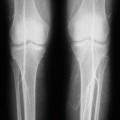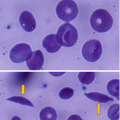(1)
Department of Surgery, Dar A lAlafia Medical Company, Qatif, Saudi Arabia
7.1 Introduction
Acute chest syndrome (ACS) is defined as a new infiltrate on chest X-ray that is associated with one or more of the following symptoms:
Fever
Cough
Dyspnea
Hypoxia
Productive cough
The ACS is a common complication of sickle cell anemia and a cause of morbidity and mortality in these patients (Fig. 7.1).
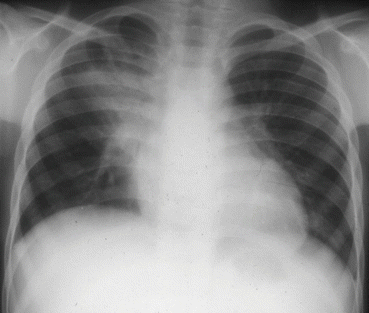
Fig. 7.1
Chest X-ray showing a mild attack of acute chest syndrome in a child with sickle cell anemia
The acute chest syndrome is considered the leading cause of death and hospitalization among patients with sickle cell anemia.
Acute chest syndrome is the second most common cause of hospitalization, second to vaso-occlusive crisis for patients with SCA.
It is considered the most common cause of death, with one-fourth of SCA-related deaths due to ACS.
The extent and severity of ACS is variable:
It can affect one segment of the lung.
Or it can extend to affect the whole lobe of the lung.
Sometimes, ACS can affect the whole lung.
Or it can be bilateral (Figs. 7.2, 7.3, and 7.4).

Fig. 7.2
Chest X-ray showing ACS affecting the left lower lobe of the lung and part of the left upper lobe

Fig. 7.3
Chest X-ray showing ACS affecting the whole left lung
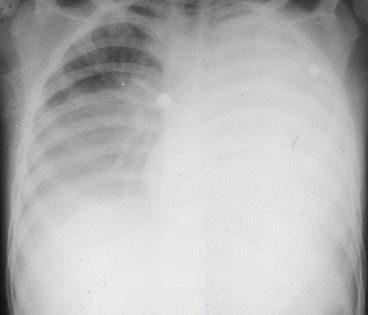
Fig. 7.4
Chest X-ray showing bilateral ACS involving the left lung and part of the right lung
ACS is seen in patients with:
Sickle cell anemia (Hb SS).
Hb SC.
Sickle-beta-thalassemia.
The incidence is higher in patients with sickle cell anemia.
The exact incidence of acute chest syndrome is not known but an estimated incidence of 10,500/100,000 patients/year was reported.
An estimated incidence of 25.3 per 100 patient-years was also reported among children with sickle cell anemia.
ACS occurs most often as a single episode, but there are certain patients who suffer multiple episodes.
The mortality is higher in those who have more than one episode of ACS.
Recurrent episodes of ACS are known to be associated with an increased risk of chronic lung disease.
Acute chest syndrome is seen commonly in children 2–4 years of age.
The incidence of ACS gradually declines with age.
The incidence of ACS is inversely proportional to the level of fetal hemoglobin and the degree of anemia and directly proportional to the steady state white blood cell count.
It is believed that high Hb F level exerts a protective effect on those less than 2 years of age and also in older patients with high HbF levels.
ACS is a common complication in children with SCA and considered the most common cause of death, with one-fourth of SCA-related deaths due to ACS.
ACS can develop:
Following an attack of vaso-occlusive crisis
Secondary to hypoxia following postoperative atelectasis
Secondary to bronchospasm due to an attack of bronchial asthma
ACS is more likely to occur in children with a history of bronchial asthma.
7.2 Etiology
The cause of ACS remains largely unknown and it is believed to be multifactorial.
Both infectious and noninfectious causes have been described.
In about 40 % of cases, a specific cause of ACS can be determined.
Infection is considered the most common cause (30 %). This is followed by pulmonary infarction (15 %) and fat embolism (10 %).
The list of causes of ACS includes the following:
Pulmonary infarction
Intrapulmonary sickling
Fat embolism
Fibrin embolism
Hypoventilation secondary to ribs or sternum infarction
Hypoventilation secondary to narcotics
Pulmonary edema secondary to narcotics or fluid overload
Postoperative hypoventilation secondary to atelectasis
Postoperative bronchospasm
Bronchospasm secondary to an attack of bronchial asthma
Infections (bacterial, viral, fungal, protozoa)
Foreign body aspiration
In about 45 % of ACS, no definite cause could be identified.
The relative frequency of the other causes of ACS is as follows:
Pulmonary infarction (15–16 %)
Fat embolism (9–10 %)
Chlamydophila pneumonia (6–7 %)
Mycoplasma pneumonia (6–7 %)
Viral infection (respiratory syncytial virus, parvovirus, rhinovirus) (5–6 %)
Mixed infections (4–5 %)
Infection is considered the most common cause of ACS in children below 9 years of age (35 %). This is in contrast to children older than 9 years of age where infection is the cause of ACS in 22 %. In adults, infection is the cause of ACS in 26 %.
The relative frequency of infectious agents as a cause of ACS is as follows:
Chlamydia (30 %)
Mycoplasma (20 %)
Respiratory syncytial virus (10 %)
Staphylococcus aureus (4 %)
Streptococcus pneumoniae (3 %)
It is estimated that about 50 % of all patients who develop ACS were initially admitted to the hospital with vaso-occlusive crises. This is especially so in those with vaso-occlusive crisis affecting the spine, ribs, and abdomen. This is attributed to several factors:
Vaso-occlusive crisis leads to pain, hypoventilation, hypoxemia, and development of atelectasis.
Add to this the respiratory depressive effect of opioids used to treat the vaso-occlusive crisis.
Both factors lead to low oxygenation which increases sickling of red blood cells.
Pulmonary infarction is a well-known cause of ACS in patients with SCA. This results from:
Vaso-occlusive crisis
Intrapulmonary sickling
Pulmonary embolus
Postoperative ACS (Figs. 7.5, 7.6, 7.7, and 7.8):
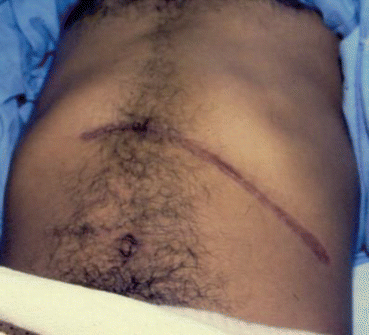
Fig. 7.5
Clinical photograph showing a patient with a large abdominal scar following splenectomy and cholecystectomy
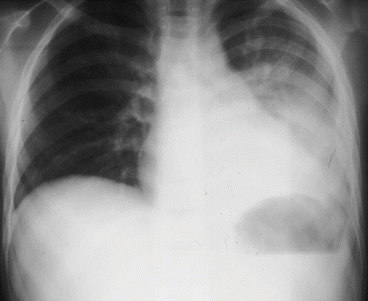
Fig. 7.6
Chest X-ray showing ACS involving the left lower lobe in a child with sickle cell anemia who had splenectomy
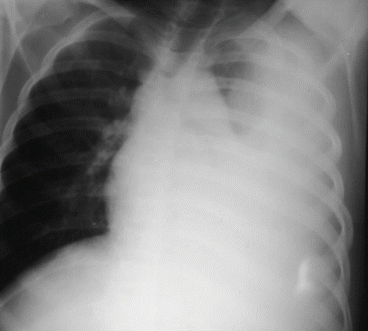
Fig. 7.7
Chest X-ray showing extensive ACS involving the whole left lung in a postoperative patient with sickle cell anemia

Fig. 7.8
Chest X-ray showing bilateral ACS in a postoperative patient with SCA
This is a well-known and serious complication in patients with SCA.
This is seen especially following abdominal surgeries with large wounds that interfere with breathing secondary to the associated pain.
The recent advancement of minimal invasive surgery may play a role in reducing the incidence of postoperative ACS. Other factors that may decrease the incidence of postoperative ACS include:
Proper preoperative evaluation.
Proper perioperative hydration.
Preoperative blood transfusion when necessary to increase their Hb to around 10 g/dl for major surgeries.
Close intraoperative monitoring and every effort should be made to avoid hypoxemia, hypothermia, acidosis, and hypercarbia.
Early mobilization and chest physiotherapy including incentive spirometry.
Postoperative ACS may develop as a result of:
Postoperative deep vein thrombosis with pulmonary embolism
Postoperative atelectasis
Postoperative chest infection
Asthmatic patients with SCA appear to be at increased risk for ACS.
It has been estimated that patients with SCA who were diagnosed with asthma were two to four times more likely to develop ACS and recurrent episodes of ACS than those without asthma.
7.3 Investigations and Diagnosis
The diagnosis of ACS in a patient with SCA is made clinically and it is based on the following criteria:
A new pulmonary infiltrate detected by chest radiograph involving at least one complete lung segment that is not consistent with the appearance of atelectasis
Stay updated, free articles. Join our Telegram channel

Full access? Get Clinical Tree





